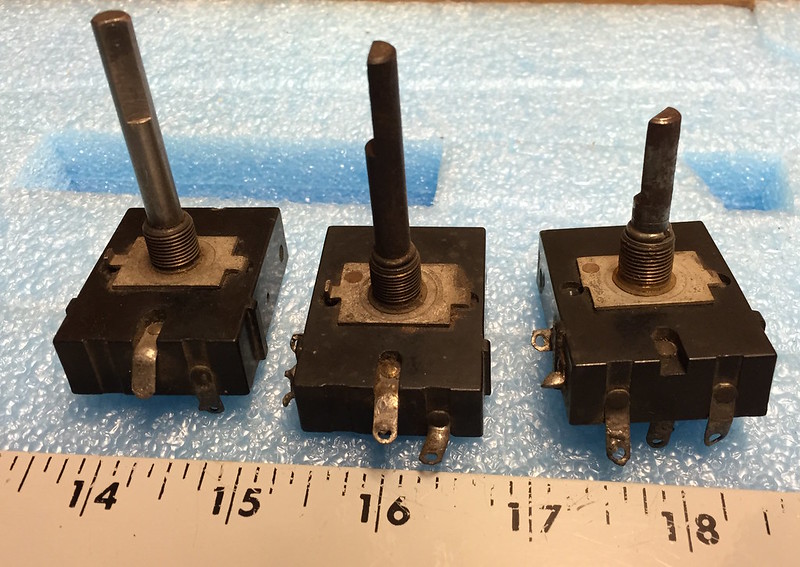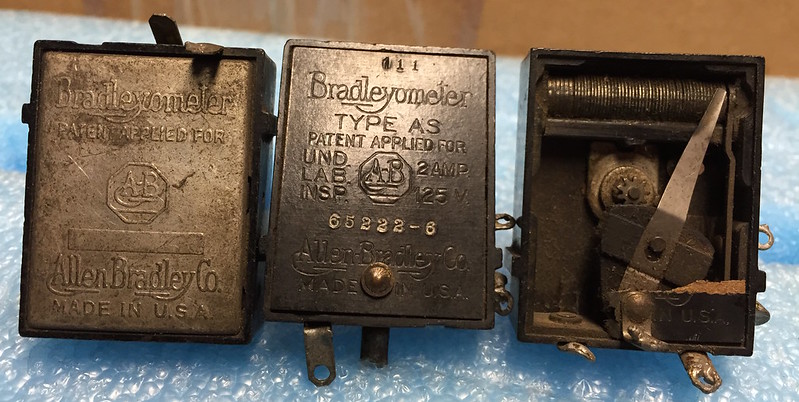You are using an out of date browser. It may not display this or other websites correctly.
You should upgrade or use an alternative browser.
You should upgrade or use an alternative browser.
The oldest Allen Bradley pots you may ever see
- Thread starter emrr
- Start date
Help Support GroupDIY Audio Forum:
This site may earn a commission from merchant affiliate
links, including eBay, Amazon, and others.
Piedwagtail
Well-known member
- Joined
- Mar 7, 2009
- Messages
- 69
Sure that metal backed one is a fake; Indonesia 2013 for the Western Electric market 
Interesting. "Bradleyometer" seems to have been a name for several different devices.
Bradley had long been making large carbon compression variable resistors for motor control.
A BradleyStat is a 2-terminal carbon-disk compression resistor typically used for filament power control (that's how they dealt with both battery fade and volume control in the day). The design naturally offers an "off" position when the pressure falls past zero to slack/gap.
The first Bradleyometer, ~~1923, seems to be *two* stacks of carbon disks with a cam to compress one and decompress the other, giving a 3-terminal potentiometer (more or less).
https://books.google.com/books?id=vd7mAAAAMAAJ&pg=RA3-PA75&lpg=RA3-PA75&dq=Bradleyometer&ved=0CC0Q6AEwAQ#v=onepage&q=Bradleyometer&f=false
In 1936 we have the Type J which is a now-conventional construction except the resistor is "a solid molded ring, not a film".
http://www.americanradiohistory.com/Archive-Radio-Engineering/30s/1936/Radio-Engineering-1936-01.pdf (page 3 of 2MB PDF)
I know I have seen a full-page ad for the type you have, but can not remember where. But the types I can find suggest yours is somewhere in the 1924-1935 period.
Bradley had long been making large carbon compression variable resistors for motor control.
A BradleyStat is a 2-terminal carbon-disk compression resistor typically used for filament power control (that's how they dealt with both battery fade and volume control in the day). The design naturally offers an "off" position when the pressure falls past zero to slack/gap.
The first Bradleyometer, ~~1923, seems to be *two* stacks of carbon disks with a cam to compress one and decompress the other, giving a 3-terminal potentiometer (more or less).
https://books.google.com/books?id=vd7mAAAAMAAJ&pg=RA3-PA75&lpg=RA3-PA75&dq=Bradleyometer&ved=0CC0Q6AEwAQ#v=onepage&q=Bradleyometer&f=false
In 1936 we have the Type J which is a now-conventional construction except the resistor is "a solid molded ring, not a film".
http://www.americanradiohistory.com/Archive-Radio-Engineering/30s/1936/Radio-Engineering-1936-01.pdf (page 3 of 2MB PDF)
I know I have seen a full-page ad for the type you have, but can not remember where. But the types I can find suggest yours is somewhere in the 1924-1935 period.
what kind of contact cleaner would you recommend for these relics?
Thanks for posting these - I too get a kick out of seeing that sort of original technology.
Jakob E.
Jakob E.
okgb
Well-known member
No machines making those!
Similar threads
- Replies
- 11
- Views
- 2K
- Replies
- 8
- Views
- 2K





